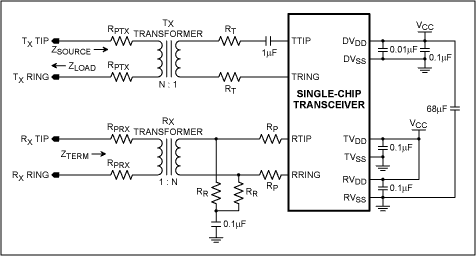
This application note provides general information about the network interface and circuit designs for secondary protection of the DS2155 SCTs. These designs are targeted for compliance with the following standards, Underwriters Laboratories UL 1950 and UL 60950, TIA/EIA-IS-968, Telcordia GR 1089-Core and International Telecommunication Union ITU-T K.20, and K.21.
Gas discharge tubes or carbon blocks located at the point where the line enters the premises usually provide primary voltage protection; but because primary voltage protection only limits the voltage surges to 1000V peak and power-line cross to 600VRMS, secondary voltage protection is necessary. Secondary voltage protection provides additional voltage and current limiting to prevent damage to the network interface device.
This application note provides general information about the network interface and circuit designs for secondary protection of the DS2155 single-chip transceiver. These designs are targeted for compliance with the following standards:
- Underwriters Laboratories UL 1950 and UL 60950
- TIA/EIA-IS-968
- Telcordia GR 1089-Core
- International Telecommunication Union ITU-T K.20, K.21
The circuit in Figure 1 is a traditional interface for T1/E1 devices and illustrates how resistance is distributed around the transformers. This model will be used as the baseline circuit for the network interface design. It contains extra resistors that are not used in the final design but are essential for many of the concepts presented in this article.

Figure 1. A traditional network interface circuit with distributed resistance for protection.
Receive InterfaceThe receiver inputs present a high impedance and require very little input current to operate. They are designed to recover a signal using a 1:1 transformer with 0Ω of series resistance under a matched load. The primary consideration in the receive circuit is the accurate termination of the transmission line. A T1 signal is carried on 100Ω balanced twisted pair while an E1 signal is carried on either 75Ω unbalanced coaxial cable or 120Ω balanced twisted pair.
The components involved in the termination network are the RPRX resistors, RR resistors, and the turn ratio of the transformer; the receive-transformer turn ratio is specified as 1:1, N = 1. The termination circuit is ideal if RPRX is 0Ω and the resistance of RR equals half of the characteristic line impedance. If the RPRX resistors are present, they form a voltage divider and RR must be adjusted. As the resistance of RPRX increases, the resistance of RR decreases. The following equation gives an example of how to calculate RR for proper termination:
ZTERM = RPRX + 2RR / N²
Substitute:
ZTERM = 100Ω, RPRX = 0Ω, N = 1 ∴ 100Ω = 2RR
Solve:
RR ∴ RR = 50Ω
To ease the design of receive termination for both T1 and E1 circuits, the D2155 selects the termination by using software. By designing the receive circuit for 120Ω termination, the internal line interface unit (LIU) can selectively add resistance to the line to achieve the additional termination settings of 75Ω or 100Ω. The LIU inserts either 200Ω or 600Ω of internal resistance between the RTIP and RRING pins.
Changes must be made to the traditional network interface when using internal termination. First, any current-limiting resistors, which include RP and RPRX, must be removed from the receive path. RP must be removed because the resistors interfere with the additional resistance that the internal circuitry adds. RPRX must be removed so the parallel resistance value of 75Ω, 100Ω, or 120Ω is formed by the combination of RR resistors and the internal resistors in the DS2155. Second, the RR resistors must be set to match a line termination of 120Ω. Since RPRX is 0Ω, the resistance of RR equals 60Ω, which is half of the characteristic line impedance.
Finally, because resistance in the circuit can no longer protect the device from overcurrent conditions, a combination of fuses and voltage suppression must be used. An example of this type of circuit along with test results is discussed later.
Note: The 0.1µF capacitor connected to resistors RR form a high-frequency cutoff filter for improved noise immunity and does not affect line termination.
Transmitter Interface The transmitter output drivers present a low impedance and are able to drive sufficient current into the primary winding of the transformer to produce the required output pulse. The transmitter outputs are designed to fit an output pulse into a template based on the line impedance, operational voltage, transformer coil winding, inline resistance, and specific mode of operation, i.e., 100Ω T1, 75Ω E1, or 120Ω E1. Unlike the receive transformer, the transmit-transformer turn ratio is directly related to the operational voltage. The DS2155 operates at 3.3V; therefore, the transformer turn ratio is specified as 1:N, where N = 2.
Since the signal pulses and the requirements for the transmit-side interface of T1 and E1 are different, the transmit circuit description is more complicated than the receive circuit. To help users easily understand, the transmitter interface description is broken into two sections. The first section covers the T1 transmitter interface; the second section covers the E1 transmitter interface.
T1 Device Transmit CircuitThe transmitter outputs of Maxim's T1 parts are designed to generate the correct pulse amplitude at the network interface for varying line lengths. Since the different line lengths affect the pulse shape, the parts have programmable output levels. Every part has a transmitter line build-out (LBO) table in the data sheet that shows the settings to choose based on the transformer turn ratio and the line length. A default T1 pulse for a known line length is generated under the following conditions: 3.3V supply; RPTX = 0Ω, RT = 0Ω; and a transmit transformer with a turn ratio of 1:2.
A nominal 0dB T1 pulse is 3V under a 100Ω load or 3V at 30mA on the network interface. An unprotected circuit using a 1:2 transformer with 0Ω series resistance will have to produce a 3V × (1/2) = 1.5V pulse at the device's output pins. The current drive into the device side, or primary winding, of the transformer will be 30mA × 2 = 60mA.
Traditionally, resistors RPTX or RT are used to protect the device from surges. But adding series resistance creates a voltage drop that attenuates the output signal pulse. To compensate for the signal loss, select a transformer with a turn ratio larger than 1:2. This increases the current draw from the transmitter outputs by more than 20%. For this reason, it is recommended that 3.3V circuits be designed with 0Ω of series resistance and other components be used for overvoltage protection.
The following example illustrates how the 1:2 transformer could be replaced by a 1:2.42 transformer if it were necessary to use RPTX or RT to protect the circuit from surges. While the current pulse in the network side or secondary winding of the 1:2.42 transformer will remain the same, the current pulse in the primary winding of the transformer will be 30mA × 2.42 = 72.6mA. Because the output voltage pulse is still 1.5V, the net impedance (RL) seen by the transmitter will be 1.5V / 72.6mA = 20.6Ω and is described by the following:
RL = ZLOAD / N² + 2RPTX / N² + 2RT
Substitute:
RL = 20.6Ω, ZLOAD = 100Ω, N = 2.42
∴ 20.6Ω = 100Ω / 5.86 + 2RPTX / 5.86 + 2RT
Simplify:
3.5Ω = 2RPTX / 5.86 + 2RT
If RPTX is 0Ω, then RT = 1.75Ω, which is not enough to significantly reduce current. However, if RT is 0Ω, RPTX can be as much as 10Ω each and will provide current-limit protection for the transformer.
E1 Device Transmit CircuitThe transmitter outputs of Maxim's E1 parts are designed to generate the correct pulse at the network interface under varying termination conditions. The programmable output levels ensure that pulse amplitude at the network interface have a peak voltage of 3.0V for 120Ω termination or 2.37V for 75Ω termination. Unlike in T1, E1 applications can have additional resistance in the transmit path to match the source impedance to the characteristic line impedance. The measure of how well the source and line impedance are matched is return loss. A higher return loss results in greater attenuation of line noise or signal reflections being coupled in the transmitter outputs and is calculated by the following:
Return Loss (dB) = 20log10 |ZSOURCE + ZLOAD| / |ZSOURCE - ZLOAD|
ZLOAD = 120Ω or 75Ω and ZSOURCE = 2RPTX + (2RT + 5) × N²
The constant 5 in the ZSOURCE equation above is the transmitter's internal impedance. The return loss for an unprotected network interface without a high return-loss condition is shown below. In the example resistors, the supply voltage is 3.3V, RPTX and RT = 0Ω, the TX transformer has a turn ratio of 1:2, and the line impedance is 75Ω.
Return Loss (dB) = 20log10 |ZSOURCE + ZLOAD| / |ZSOURCE - ZLOAD|
Substitute:
ZLOAD = 75Ω, N = 2, RPTX and RT = 0Ω
∴ Return Loss = 20log10 |5 × 22 + 75| / |5 × 22 - 75|
Return Loss = 20log10 1.73 = 4.7dB
In this example, 58% of the noise or reflected signal can be coupled into the transmitter outputs. To improve the return loss, the value of RT can be increased. Changing RT to a value of 6.2Ω increases the return loss to 28.5dB. This means less than 4% of the inbound signal will be reflected. Because any series resistance will affect the pulse amplitude, the DS2155 compensates for specific RT or RPTX values. When designing the network interface, use Table 1, which is also found in the DS2155 data sheet, for proper transformer and resistor selection. Each setting is based on the operational voltage, the transformer turn ratio, and RT.
Table 1. LBO select for DS2155 3.3V devices
欢迎分享,转载请注明来源:内存溢出
 微信扫一扫
微信扫一扫
 支付宝扫一扫
支付宝扫一扫

评论列表(0条)